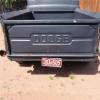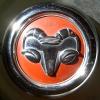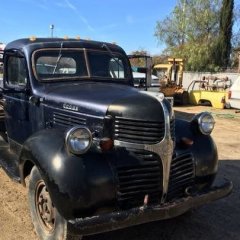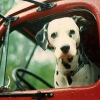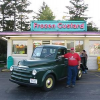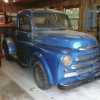Leaderboard
Popular Content
Showing content with the highest reputation on 10/17/2018 in all areas
-
I finally have some good information after talking to Bruce Horkey directly. The Pilothouse series was designed with four steel crossmembers supporting the wood planks which are 3/4 in thick. Front to rear (I call them # 1 to #4), the first three crossmembers are 48 5/8 in. long and the rearmost crossmember (closest to the tailgate) is only 40 1/8 in. long. The first two crossmember are bolted to the frame using bolts that fit through large 3 in. diameter washers. Crossmember number three is kind of odd because it is a floater. It does not bolt to the frame. The only bolts that hold it in place are the bolts that pass through the skid strip holes directly above it. The rearmost crossmember also bolts to the frame using the same bolts and large 3 in. washers as crossmembers #1 and # 2. Dodge realized that it had to cushion the four crossmember from riding directly on the frame so crossmember #1, #2, and #4 were cushioned by 1/4 in. thick square-shaped insulators made of some kind of waterproof material. Crossmember #3 was supported by two 1/4 in. thick round rubber insulators which were not bolted to anything. Instead, the #3 rubber insulators are held in place by nubs molded onto one side that are inserted either into holes in the crossmember (nubs up) or the holes in the frame (nubs down). Either way is OK since there is no way for them to fall out because the nubs hold the rubber insulators firmly in place. The rubber insulators I posted in my original post are incorrect. At 3/4 in, they are too thick. Horkey is sending me the correct 1/4 in. thick rubber ones along with six 1/4 in. thick waterproof cotton insulators for the other three crossmembers. Horkey's stocks all the parts for Pilothouse beds and has been very responsive and easy to work with.3 points
-
They are above the scrub line by a good inch or so. Speaking of scrub, its close on the wheels to the bottom of the axle. As long as just one tire goes flat on that axle at a time, we should be fine... two, well thats another story.1 point
-
Perhaps you could start your own build thread since you want to address multiple issues beyond the original scope of this thread... front seals rear seals1 point
-
I looked in the repair manual, not the best way to view these but all I have to reference seeing as my cars are 41 and up......the rear frame connector may be the limiting factor....and then again, could be modified to accept the later shackes...without seeing how it is made I regretfully cannot advise on how to begin this. My earlier statement still stand for those springs as pictured, even modified, you need correct shackes and ones that are shouldered so to properly center and provide the proper squish on the bushings... distances should be 1.980 to 2.000 between the side plates...1 point
-
Ok, we need to figure out just what you are talking about. You have an early 3/4 ton WC-51 with the 8.75” ring and pinion third members right? You switched out the 5.83 r&p’s for 4.89’s then right. Good luck finding one set of 4.30 r&p’s let alone two. Your best bet would be to locate 2 good used 4.30 8.75” third members and bolt them right in. This ratio was used in all 1ton dodge trucks from 1940-1952-53. The DU route van also used this ratio. The side gear spline size was changed in the civi trucks from 1945 onwards so make sure if you purchase a post war third member that you have the right axle shafts to go with it. 3.91 and 4.10 ratios were also available, but those are very rare also. You need to keep in mind that in going with a lower numbered ratio you will gain more top end speed but lose power going up hills. Believe me I know. I am running 4.30’s in my 1/2 ton WC with 900-16 tires. I have a 25” 236 Flathead in it which is mostly stock. It cruises good at 55-60, but anything more than a moderate hill and it losses pulling power quickly. Those 900-16’s are a heavy tire and wheel. Things to think about when switching out ratios in these old trucks.1 point
-
The hub must be tight, also the axle bearings and end play must be on specs. Check the surface on the hub where the keyway could interfere with the seal.1 point
-
Be sure to share pics of the stainless trim when you get it straight. When I straightened mine, I found that I had better luck using hardwood as the dolly - less chance of stretching the stainless. Do you plan to polish it out or just going for straight? I found out the hard way that you can’t skip any steps in sandpaper. I ended up starting with 100 grit paper and progressing through 2000 grit (wet/dry when available) without skipping any steps, then three different polishing compounds. Lots of time but worth it in the end.1 point
-
OEM '35-39 rear spring rear shackles are screw type U-shape with grease fittings. OEM springs used with these shackles have corresponding threads. Later bracket style shackles do not have threads or grease fittings, they have rubber bushings instead. OEM shackle Later style shackle1 point
-
yes she knows I talk to naked women.....to be honest I only talk to about 4 women other than the wife and she will tell you straight out, I always ask them if they are naked.....she does have a facebook account....her reply when I just now asked her opinion about it, gawd awful stupid 95% of the time..but her sisters are on there...1 point
-
Late model shackles are too wide for use with the early springs. One must remember that the shackle bolts are welded to one side strap and open on the other for the strap to slip on and nut up... the shoulder of this bolt is for the diameter of the bushing inner hole...the threaded end is stepped down as is the hole on the matching side strap..the length of this shoulder is specific to the width of the springs...1 point
-
stainless pipes and cast iron manifolds have been the go-to since early 90's for most cars on the highway today.....there is no need to be concerned about anything except wrecking the vehicle in an unfortunate accident. One thing you did not address...welding the flange to the pipe as these are not ball socket connection to the manifold....get that flange welded...1 point
-
I've not heard of stainless steel and cast iron reacting to each other, certainly using a copper head gasket on an aluminium head is asking for trouble but stainless and cast iron is not something I'd be concerned about...........I'd certainly be using stainless bolts with brass nuts and a wipe of neverseize on the bolt threads but with that nice what looks to be 3/8"thick flange I'd think it would be fine.............check with a local exhaust supply/muffler fitting company or maybe an engineering supplier but as I have said I've never heard of stainless and cast iron reacting and would make the new stainless pipe flange exactly the same as the mild steel one...................regards....andyd1 point
-
1 point
-
that will be quite close to the header...will you be able to install a heat shield? A little space between header and coupling will do wonders..the heat will cook any lube quickly and cause tight steering to even a possible binding...1 point
-
1 point
-
1 point
-
Thanks for the votes of confidence guys!. I'll get some inside pics, Seat and dash are refurbed, still need to do the roof insert and door cards. Merle thanks for the info, the trans shifts well just not a lot of top end, so the rear end might be the right way to go for me. What is the ratio of the original rear axle? I have the stainless strips from DCM and bought the hardware from ACE hardware here in VT, I had some red oak trees cut in my yard and had a portable sawmill come here and cut into boards. I just need to make the time to plane them and mill to size. But in keeping with this project theme - do all I can myself.... to me it's kinda cool that the wood grew on my land and now I'll make it part of this project.1 point
-
so no one has heard of this ? I bought a 1949 route van parts book ad no mention of 4.30 ratio, anyone need this manual ?0 points
-
I appreciate a story where a man is not afraid to get his feet wet and dive in and learn some interesting things along the way and learn and hone some skills at the same time...Congrats...more fun that writing checks for those monthly payments...0 points


